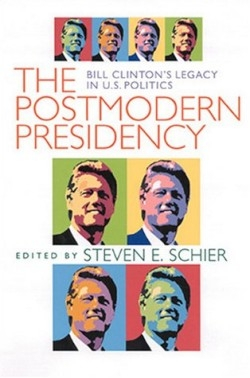It looks like you've stumbled upon a page meant to be read by our code instead of viewed directly. You're probably looking for this page.
The Postmodern Presidency
Bill Clinton's Legacy in U.S. Politics
How President Clinton-a “shape-shifter” on policy issues and the possessor of a character weak enough to have probably destroyed former presidencies-has been able to survive and prosper as a “new Democrat” in a decidedly Republican political environment, is the perplexing theme pondered here by twelve, respected political scientists and one journalist.
The Clinton administration, the contributors agree, will be remembered as a postmodern presidential era, a time of divided government that called for a leader without a strong ideology or partisan commitments, notes Bruce Miroff, in a lucid essay that defines postmodernism. Clinton has survived because of declining public expectations about character and not because he is viewed as a moral leader. His policy of “shape-shifting” led the president to not only endure the gays in the military, health care fiascoes, and the 1994 Republican takeover of Congress, but also proudly proclaim in his second term the end of the era of big government.
The postmodern president becomes whatever the public wants him to be at any given time. Journalist John Harris credits Clinton with creating the permanent campaign, which Schier concludes, is, for better or worse, Clinton’s most enduring legacy. The permanent campaigner makes no distinction between campaigning and the act of governing. Policies-much like elections-are crafted around polls and issues appealing to special interests. Richard Morris, Clinton’s controversial pollster, promoted the successful triangulation strategy, whereby the president gained support for his policies by assuming a postmodern centrist position that co-opted Republican policies, all too frequently at the electoral expense of his natural liberal constituency.
John Coleman refines postmodernism by joining it with the model of the preemptive president, presented by Stephen Skowronek in his important The Politics Presidents Make: Leadership from John Adams to George Bush (Harvard, 1993). Skowronek defines a preemptive president as one not allied with the current policy regime, in this case, Coleman notes, a Democratic president squaring off with a Republican House and Senate. Clinton has enjoyed preemptive success by skillfully triangulating between the agendas of both parties.
The 1990s, however, were not years of a Democratic ascendancy, despite Clinton’s two terms, states Nicol Rae. Republicans not only gained control of Congress but also a large majority of state governorships. Even state legislatures, once solidly Democratic bastions, are now as likely to be Republican as Democrat. Rae concludes that Clinton has left no enduring legacy for the Democrats: the perilous postmodern landscape of divided government and parties divorced from the needs of voters is what remains.
Other contributors assess Clinton’s postmodern economic foreign policy, gender and minority group legacies, and the still uncertain impact of his failed impeachment. This fine collection
of first appraisals will not be the final explication of the Clinton era, but will serve as an important source for those that follow.
Reviewed by
Karl Helicher
Disclosure: This article is not an endorsement, but a review. The publisher of this book provided free copies of the book to have their book reviewed by a professional reviewer. No fee was paid by the publisher for this review. Foreword Reviews only recommends books that we love. Foreword Magazine, Inc. is disclosing this in accordance with the Federal Trade Commission’s 16 CFR, Part 255.
